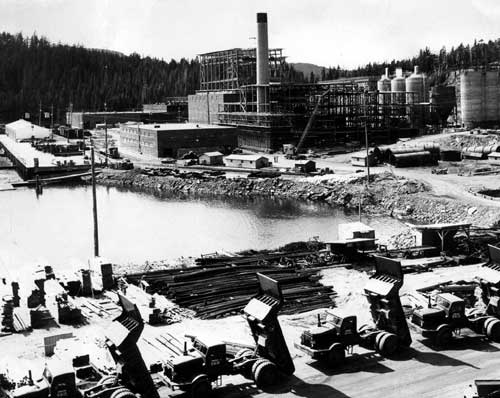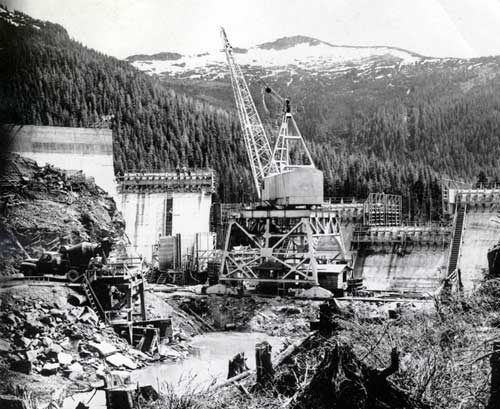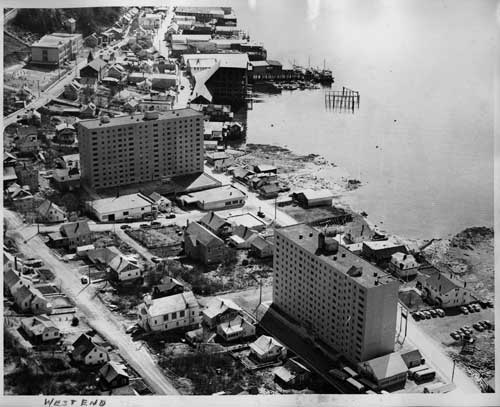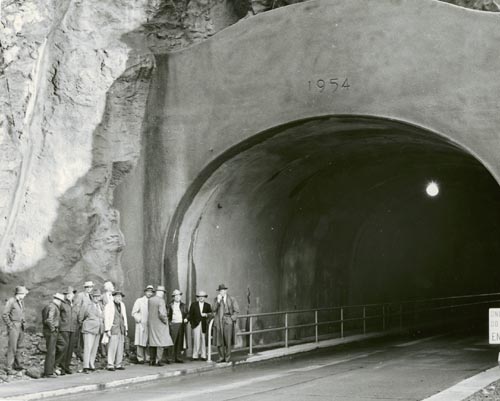 Boom Town, Ketchikan in the 1950s By DAVE KIFFER February 20, 2006
While the Depression had had less of an effect here than elsewhere in the country, the economic boost of the war years had artificially supported the local economy. With the end of the war, it became obvious that the dominant industry - the canned salmon industry - was in sharp decline and as the fishing industry waned so did Ketchikan. When the canning industry boomed in the 1920s and early 1930s, Ketchikan had risen to a population of nearly 6,000 and for a time was a largest city in the state. But by the end of the war, the population had dropped back to down to 4,500 and there was no sign of any industry that would make up the jobs that were being lost each time a cannery closed. In order to boost the economy of Ketchikan and the rest of Alaska, the federal government looked toward the Tongass National Forest and the billions of board feet of timber that it contained.  This photograph is from Weston Davis' Grandmother's collection. Davis said as far as his Grandmother knows, the photographer has passed away. His name was Alex Kamkoff, an engineer working on the pulp mill construction project. The photo was a gift (1953).
"After 1920s surveys showed Alaska timber suitable for pulp and paper production, Deputy Forest Supervisor (later Territorial Governor) B. Frank Heintzleman began a 30 effort to establish a pulp industry in Southeast Alaska," June Allen wrote in her 1992 history of Ketchikan "Spirit." "The first mill built near Juneau in 1920 failed, and the first 50-year Forest Service contracts awarded in 1927 were canceled during the Great Depression. World War II further delayed wood pulp industry development." In 1947, the federal government tried again as Congress passed and President Harry Truman signed the Tongass Timber Act, which was designed to attract investment by offering a guaranteed quantity of timber to those willing to invest in physical plants capable of processing the timber in southeast Alaska. In 1948, the US Forest Service accepted a bid from Ketchikan Pulp and Paper Company ( jointly owned by Philadelphia-based American Viscose and Puget Sound Pulp and Timber) for a bid to operate a viscose-process pulp mill at Ward Cove. The rush was on. In 1954, the mill was completed and KPC signed a 50 year contract for up to 8.25 billion board feet of timber to service the mill. "In the agreement, KPC was granted harvest rights on fewer than a million acres of Tongass forest lands, mainly on parts of Prince of Wales and Revilla Islands," Allen wrote in 1992. Total Tongass National Forest acreage is just under 17 million acres. Construction of the mill took nearly 1,000 workers many of whom moved to Ketchikan for the duration of the two year $54 million job. Housing was at a premium and local developers took advantage of a change in Federal law that offered economic incentives for large apartment complexes.  This historical photograph is from Weston Davis' Grandmother's collection. Alex Kamkoff was the photographer - he was an engineer working on the pulp mill construction project. The photo was a gift to Davis' Grandmother.
Other smaller apartment buildings such as the Louise (now the Deer Mountain Apartments) were also built during this time as were numerous private houses. The Carlanna neighborhood above Charcoal Point began to develop with smaller roads branching off Baranof. The biggest local housing development in the early 1950s was originally called Tongass View and took in the heights above the new Ketchikan High School. Originally 200 homes were planned for the Jackson Street neighborhood but only 45 built. Many of the KPC management employees had homes on Jackson Street, which was also called "Blueberry Hill" for many years. It wasn't until the 1990s that most of the rest of the Tongass View subdivision was developed. Houses also quickly bloomed in the Heath Addition area, the old Heath homestead where First, Second, Third and Fourth avenues currently are. The federal government also realized that low income housing would also be needed and built the Alder Park Public Housing project on Bryant Street which served 100 low income families for nearly three decades. It has since been replaced by the Ketchikan Pioneers Home and the Seaview Terrace senior housing development. Although many of the workers were single, some also brought their families and it was estimated that most of the permanent 500 mill workers would bring families in from Outside. New residents meant a great strain on local schools. A new Ketchikan High School was built on Fourth Avenue and opened in 1954, leaving the old high school downtown to become the Old Main Elementary School. White Cliff Elementary was also expanded in 1952 to a capacity of more than 500 students.  Photographer: Paulu T. Saari Donor: Paulu T. Saari, KM 2005.2.63.56 Photograph courtesy Ketchikan Museums
Between 1950 and 1960, more than 1,000 new residents came to Ketchikan proper. Pushing the total to nearly 6,500. The population outside the city limits grew even more dramatically, from around 1,500 to nearly 3,500 residents. The rapidly increasing population also led Ketchikan to finally deal with some road infrastructure challenges that had been vexing locals for years. There had been plans as early as the 1920s to tunnel through the Knob Hill hillside that effectively blocked the Downtown area from the Newtown area. Although a wooden trestle had been built connecting the two areas as early 1902, the narrow trestle had to be enlarged several times as the community grew and automobiles replaced dray horses. With hundreds of thousands of federal highway improvement dollars flowing into the community, the 275 foot tunnel project got the go ahead and by 1954, Ketchikan had the only tunnel in America that one could drive through, around and over. Other road projects also helped to spread the community out. North Tongass had been little more than bumpy, rutted one lane road from Ward Cove on out, but it was dramatically widened and much of it was paved. South Tongass was paved and widened all the way out to Herring Cove.  Photographer: Paulu Toivo Saari Donor: City of Ketchikan, Tongass Historical Society 80.1.5.137 Photo courtesy Ketchikan Museums
Industrial areas were also developed including the Peninsula Point sea plane base which had previously been a community picnic area between town and Ward Cove. Development of Ketchikan's largest boat harbor, Bar Harbor, also began in the early 1950s. Beyond the tunnel, Water Street was more than doubled in size and many of the buildings in the cramped Newtown neighborhood were either demolished or moved - some such as the Nordby and Northern Machine buildings were moved as far as 30 feet - to make room for the new road. Farther out, Tongass Avenue was also widened from its single lane wooden trestle leading to the first real development of Ketchikan's West End, which had previously been considered the Charcoal Point neighborhood. But as Ketchikan grew, the Downtown area also became more crowded. Part of that was an unintended consequence of the closing of the Creek Street Red Light District in 1953. Prostitution and other vice didn't go away, a lot of it moved into the numerous Downtown residential "hotels" which were also booming because of the high number of single construction and mill workers coming into the area. As a result of the crowding Downtown Ketchikan saw some its most spectacular and infamous fires in the mid 1950s. One spectacular blaze took out several popular local haunts including the Bamboo Room, the Peter Pan and Hamburger Heaven - which earlier est a local record by selling more than 5,000 hamburgers in six weeks. That fire, along with several others, was later attributed to Ketchikan's home grown fire bug, Fire Lt. Bill Mitchell. By the time the first bale of pulp left the new Ketchikan pulp mill on July 1, 1954, Ketchikan had been changed irrevocably. A new economic engine had fired up and the era of year round jobs had finally reached Alaska's First City. Gone was the half-century local economy in which all activity took place in the summer and everyone operated on credit through the long winter. In subsequent years, state officials would consider Ketchikan as having one of the most diverse economies in the state. Local officials would proudly point at the three-legged stool of timber, fishing and tourism (in addition to being the service area for the expanding outlying areas). That all began in the mid 1950s and lasted for more than 40 years.
Editor's Note: The Tongass Historical Museum is currently running an exhibit of photographs from the mid 1950s by Paalu Saari entitled "Boom Town, Ketchikan in the 1950s." The exhibit will be showing until April 16th.
Related stories:
Contact Dave at dave@sitnews.us Dave Kiffer ©2005
|